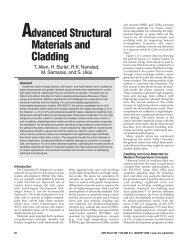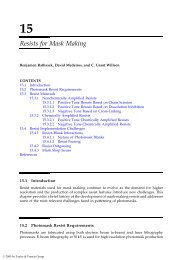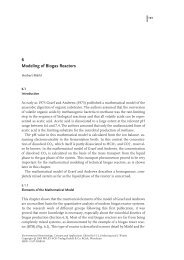SPECIAL SECTIONS: Filter Media Valves Advertising closes October 3
SPECIAL SECTIONS: Filter Media Valves Advertising closes October 3
SPECIAL SECTIONS: Filter Media Valves Advertising closes October 3
You also want an ePaper? Increase the reach of your titles
YUMPU automatically turns print PDFs into web optimized ePapers that Google loves.
14 SEPTEMBER 2008 | PBEI<br />
There are two classes of FFS machines: gross-weight and<br />
net-weight. In gross-weight systems, the bag is weighed on a<br />
live scale as it’s filled. In net-weight systems, the material<br />
passes through a weigh-hopper before entering the bag.<br />
Gross-weight machines are more compact than net-weight<br />
machines. They also handle products more gently and are<br />
commonly used to bag high-value materials, such as engineered<br />
resins, where capacity is low and a vapor barrier is required.<br />
Gross-weight machines are also well suited for<br />
applications that require frequent product changes and thus<br />
frequent cleaning. Outputs of FFS machines are 100 to 1,800<br />
bags per hour.<br />
FFS options. One option is to affix nozzles to the bagging<br />
machine to clean material contact areas automatically. Another<br />
option is an air evacuation system that removes air from the bag<br />
and shrinks the gaps between particles. There is also a gussetfolding<br />
device on the market that enables you to transform flat,<br />
tubular film into gusseted film. See Figure 4. The advantage:<br />
Rolls can hold double the amount of tube-stock compared with<br />
gusseted film. Finally, an optional embossing device reduces the<br />
tendency of bags to slip around on the pallet.<br />
1. Storage silos<br />
2. Mobile batch weigher<br />
3. Mobile semi-bulk filler<br />
4. Mobile FFS bagging machine<br />
5. Mobile belt conveyors<br />
6. Palletizer<br />
7. Stretch-hood machine<br />
8. Multiple-level warehouse<br />
9. Outside storage<br />
9. Outside storage<br />
Figure 5<br />
Logistics terminal<br />
Layout of the packaging operation<br />
In general, FFS bagging lines (including palletizing and<br />
loading operations) operate at 65 to 75 percent of the design<br />
capacity of the FFS machines. In operations that handle a single<br />
material, the FFS machine is stationary and material enters<br />
the packaging line directly from a nearby silo. Operations that<br />
package a large percentage of product in FIBCs or do a lot of<br />
bulk load-out to trucks, will usually select stationary bagging<br />
equipment. That is because FFS quantities are smaller and it is<br />
more practical to bring the product to the bagging machine<br />
instead of moving the bagging machine.<br />
Logistics terminals, however, handle many materials, and<br />
flexibility is key. Thus, they are better served by mobile FFS<br />
machines. See Figure 5. Instead of transporting the material to<br />
the FFS machine from a silo, workers move the FFS machines<br />
to the storage silos. In this way, the product in each silo is<br />
bagged, loaded into silo trucks, or placed in FIBCs on demand—without<br />
the complication of long-range scheduling.<br />
The two drawbacks to mobile FFS machines are higher labor<br />
costs and higher equipment costs compared with stationary<br />
machines. The higher equipment cost doesn’t fall only on the






